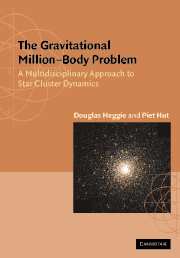Book contents
- Frontmatter
- Contents
- Preface
- PART I INTRODUCTIONS
- PART II THE CONTINUUM LIMIT: N → ∞
- PART III MEAN FIELD DYNAMICS: N = 106
- PART IV MICROPHYSICS: N = 2
- PART V GRAVOTHERMODYNAMICS: N = 106
- PART VI GRAVITATIONAL SCATTERING: N = 3
- PART VII PRIMORDIAL BINARIES: N = 4
- PART VIII POST-COLLAPSE EVOLUTION: N = 106
- PART IX STAR CLUSTER ECOLOGY
- Appendix A A Simple N-Body Integrator
- Appendix B Hints to Solution of Problems
- References
- Index
PART V - GRAVOTHERMODYNAMICS: N = 106
Published online by Cambridge University Press: 05 June 2012
- Frontmatter
- Contents
- Preface
- PART I INTRODUCTIONS
- PART II THE CONTINUUM LIMIT: N → ∞
- PART III MEAN FIELD DYNAMICS: N = 106
- PART IV MICROPHYSICS: N = 2
- PART V GRAVOTHERMODYNAMICS: N = 106
- PART VI GRAVITATIONAL SCATTERING: N = 3
- PART VII PRIMORDIAL BINARIES: N = 4
- PART VIII POST-COLLAPSE EVOLUTION: N = 106
- PART IX STAR CLUSTER ECOLOGY
- Appendix A A Simple N-Body Integrator
- Appendix B Hints to Solution of Problems
- References
- Index
Summary
The following three chapters begin the application of earlier results to the millionbody problem itself. Chapter 16 discusses two effects of two-body gravitational encounters: escape and mass segregation. The first of these actually develops the theory of two-body relaxation further, as we cannot, in this context, approximate encounters by any small-angle scattering approximation. This approach is, how ever, applicable to mass segregation, which is an effect of the tendency to equipartition of energies in two-body encounters. It also has an important influence on the stability of the million-body problem (the ‘mass stratification instability’).
Chapter 17 is also concerned with instability,b ut an instability which even exhibits itself in systems with equal masses. It was first discovered through a remarkable thermodynamic result obtained by Antonov, which helps to explain the relevance of the term ‘gravother modynamics’. This chapter deals with extrema of the entropy, and the stability of linear series of equilibria.
Chapter 18 follows up the previous two chapters by tracing the consequences of the mass stratification and gravothermal instabilities. This is the process referred to as core collapse. In other contexts this would be referred to as an example of “finite-time blow-up” and, in common with other examples of this behaviour, it can be described asymptotically by approximate self-similar solutions of the governing equations.
- Type
- Chapter
- Information
- The Gravitational Million–Body ProblemA Multidisciplinary Approach to Star Cluster Dynamics, pp. 153Publisher: Cambridge University PressPrint publication year: 2003



